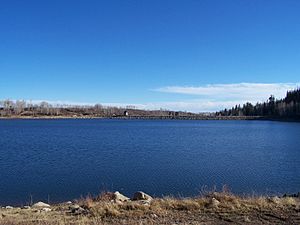Kolob Creek Dam facts for kids
The Kolob Creek Dam (also known as National ID # UT00164) is a large structure in Washington County, Utah. It helps manage water in the area. This dam creates a beautiful lake called Kolob Reservoir.
Contents
Kolob Creek Dam: What It Is
Kolob Creek Dam is an important part of water management in Utah. It is built from earth, like a big hill of dirt and rocks. The dam was finished in 1956. It was built by two companies: the Hurricane Canal Company and the Washington Fields Canal Company.
How Big Is the Dam?
The dam is quite large! It stands about 67 feet (20 meters) tall. Its top stretches for 686 feet (209 meters) across the land. The dam's main job is to hold back the water from Kolob Creek. This helps prevent floods. It also stores water for farmers to use on their crops. Today, the local Washington County Water Conservation District owns and operates the dam.
Kolob Reservoir: A Special Lake
The dam creates a lake called Kolob Reservoir. This lake covers about 249 acres of land. That's like 188 football fields! When the reservoir is full, it can hold a lot of water. It can store up to 6,914 acre-feet of water. An acre-foot is the amount of water needed to cover one acre of land with water one foot deep.
Visiting Kolob Reservoir
While Kolob Reservoir is pretty, there are not many places for visitors. In the winter, you can only reach the reservoir by snowmobile. Most of the land around the lake is private property. This means you can only camp very close to the lake itself. Fences show where the private land begins. Fishing is allowed, but there are special rules you need to follow.
Staying Safe Near the Dam
The water conservation group has been working to make the reservoir bigger. They have also improved some visitor areas. If you are a technical climber exploring the rugged canyons downstream, it's important to be careful. The area below the dam is a narrow slot canyon in Zion National Park.
Water can be released from the dam at any time. These water releases can be very powerful. They can create dangerous conditions in the canyon. If you plan to climb or hike there, always contact the Washington County Water Conservation District first. Ask them for their water release schedule. Knowing when water will be released can help keep you safe.


